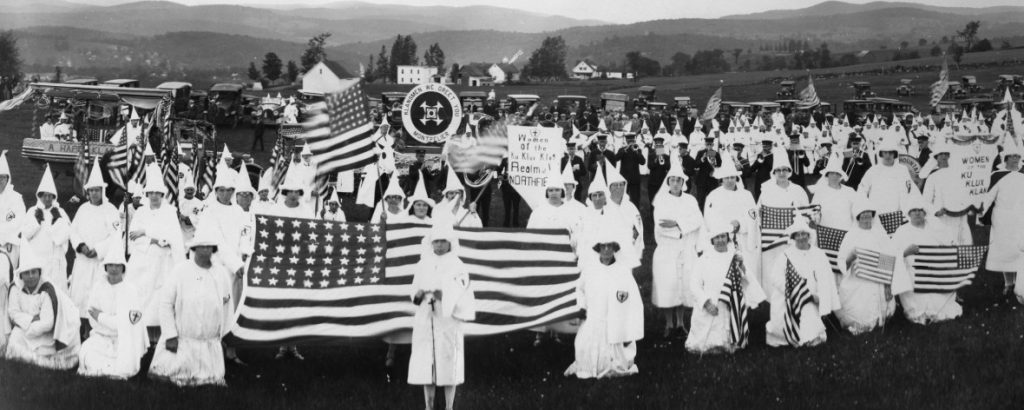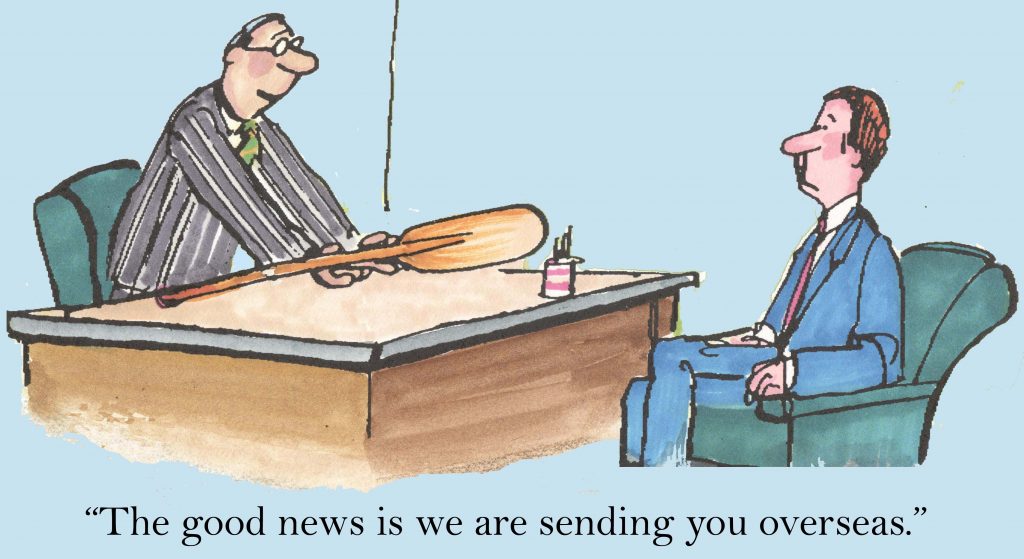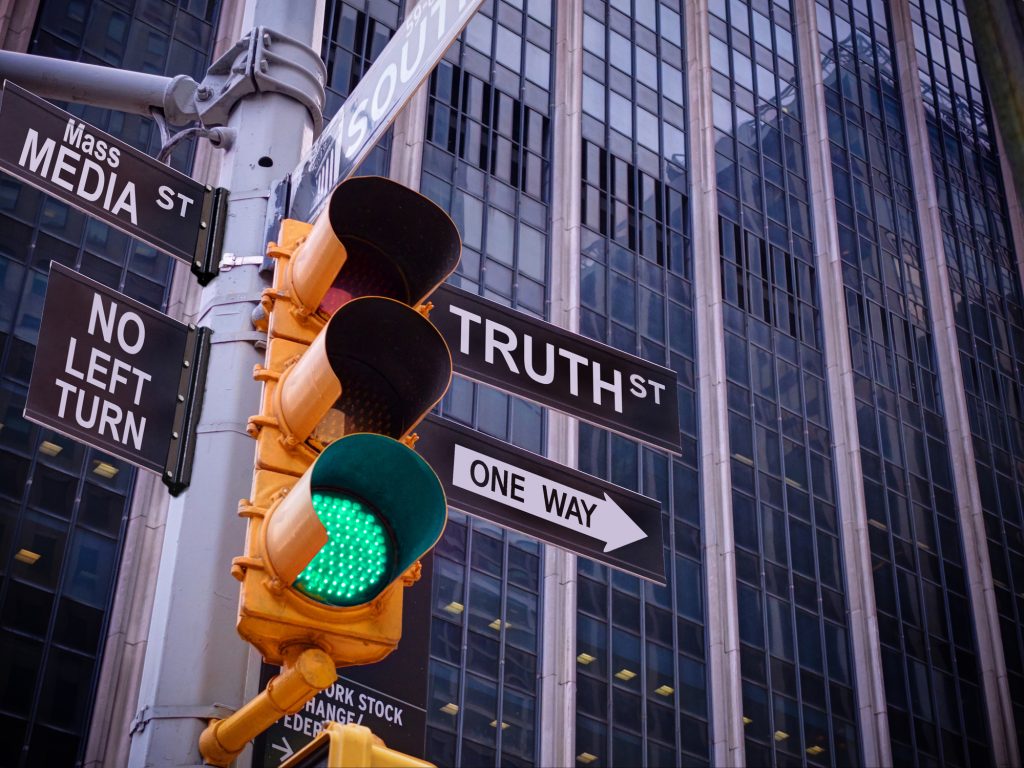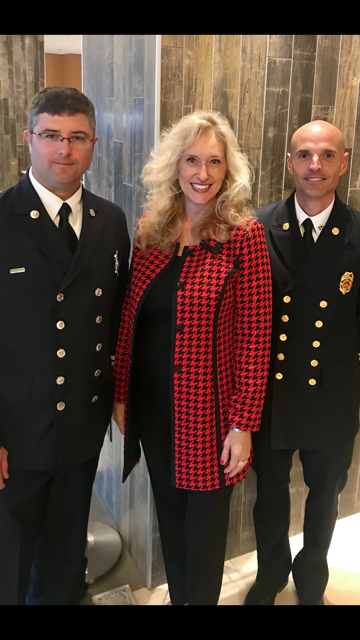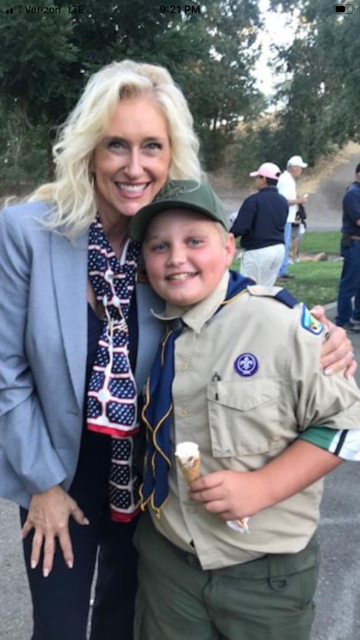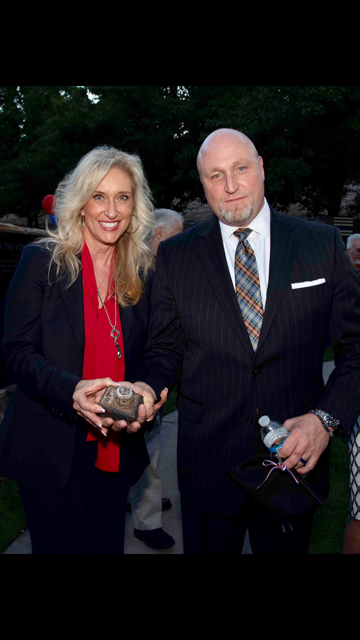We are living in an interesting time, to put it mildly. We are not merely at a crossroads, we are at a strange, almost frightening intersection—a convoluted one—of threats and opportunities, influences and ideologies. Daily, we are challenged to decide, is this fact or fiction? Can I trust what I am hearing, or what I see with my own eyes? Who can I believe when even the “experts” disagree? They change their stories so often, much of the time I just tune it all out go with my gut.
Some people have thrown out a kind of anchor to the world, as if to tell us all that, by gosh, they know where they stand on things. You’ve seen them—the little signs in front yards with multiple cute slogan lines that begin, “In This House, We Believe…”
If you have one of these signs in your front yard, please don’t take what I am about write, wrong. But as someone who has worked in media for a few years, I have discovered that we sometimes forget that communication between individuals is a two-way street. We get so caught-up in formulating the “transmit” side of the equation, we forget the “reception and interpretation” side.
What do I mean? Well, for instance, it took me more than an hour to compose the previous three paragraphs you just read in a few seconds. Seriously, it took that long.
The reason I don’t have a sign in my yard is that I know how my mind works, and when I read the words on signs like those my head is instantly flooded with thoughts and questions. And I assume that’s true for other people, so I would want my message to be crystal clear.
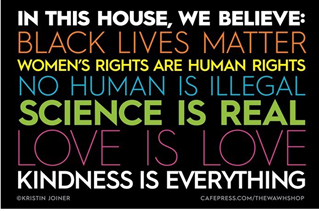
I’ll use one popular yard sign I’ve seen in my neighborhood as an example, and share some of my thoughts about each line on it. The sign begins with that proclamation, “In This House We Believe:”
Line 1: Black Lives Matter
My first thought is the politically incorrect one—”of course they do, as do all lives!” That includes those not yet recognized for their unique DNA—unborn children of every race. It also includes the lives of mostly young black males who die in gang violence every day, who are rarely considered worthy of media attention. So far this year, as of September 13, 2020, there have been 538 homicides in the city of Chicago alone. Not all of these were young black males of course, but most were. This is primarily black-on-black crime, clipping along at a rate of just over 63 killed per month, or 2.1 dead per day.
With this in my mind, I then ask myself, “Was this what my neighbors were thinking when they bought and planted that sign? These types of numbers have been sort of commonplace for a long time, not just in Chicago, but in many big cities throughout our country. Why did the sign just go up a couple of months ago?”
Then I remember and say to myself, “Oh yeah—George Floyd. He was killed and the African American community, in toto, said, ‘That’s it; we’ve had enough killing of blacks by police. White people in this country must realize—they must admit—that the police are murderers. And if those white people don’t repeat this mantra that we (the Spokespeople for All African Americans) coined a couple of years ago in Baltimore—that “Black Lives Matter”—they are then, by default, racists.”
But then I think, “Well, wait a minute. What about those hundreds of black people who died last year in Chicago, and those who died in Detroit in 2018, and the ones the year before that, and for all the years before that, too? Didn’t you (the Spokespeople for All African Americans) know about all those killings? Maybe because most of the black people who were murdered were killed by other blacks, so does that mean their lost lives are less valuable?” Personally, I don’t think that, but maybe my neighbor with the sign does.
After my mental gyrations over line number one on the sign, I just do what I suggested above—I go with my gut (which, by the way, isn’t a “thin air” thing; it’s about a few years of experiencing life).
I figure that BLM has something else in mind aside from their clever, emotionally charged, white-guilt-inspiring slogan. Looking at it logically, the Spokespeople knew the numbers, but chose a particular incident at a particular time to press forward with their “movement”—one that has very specific political, economic, and social objectives that are quite far removed from any notion of preserving lives—of any race.
My gut also tells me that my neighbors’ sign-posting motivations are a weird mix of psychological reflexes that are a blend of BLM-inspired white guilt, and BLM-inspired fear. It may be their way of saying to other white people in the neighborhood, “See, I am a good person. I am not a racist (but you might be if you don’t have a sign), and that makes me, at least a ‘little better’ than you.”
It simultaneously says to blacks (and the “edgy” activist whites) who might drive by, “See, I am good person because I am repeating ‘the mantra’ that proves it. I am not a racist (but my neighbors who don’t have signs might be), and by the way, if you decide to start breaking stuff, setting fires, or chanting and yelling in the middle of the night, you can pass this house because ‘we are on YOUR side.’”
Line 2: Women’s Rights Are Human Rights
I’m a little unsure about what this one is all about. Is the poster saying some people think women aren’t human? Do they think the laws are unjust—that women don’t currently have the same rights as men in America? Or are they saying that women don’t have the same “opportunities” as men? We’ve all heard the claim that, on average, women earn only 57-70% of what men earn doing the same job.
Okay, maybe I am a blind idiot, but in my 65 plus years of living in this country, I have never seen, known of, or heard about a single case where a woman was not afforded the same rights as men. Now if we are talking about something like the military draft, I don’t really know—do women have the “right” to be drafted into the service, should selective service again be activated? Do they want to be drafted if war breaks out with North Korea?
In the October 2018 issue of ALIVE I wrote about a film entitled, The Red Pill: A Feminist’s Journey into the Men’s Rights Movement, by film producer, Cassie Jaye. (https://aliveeastbay.com/?s=jaye). Cassie was, at the time, an avid feminist who embarked on a mission to expose American “patriarchy,” and set things aright in terms of women’s rights, equality in the workplace, etc. By the time she was finished, she no longer considered herself a “feminist.” What Cassie discovered was that most laws and benefits in America favor women over men, as do health programs.
The statistical data generally shows that men, by and large, do the “dirty work,” that most women simply don’t want to do. Don’t believe me? While women have the right to work as firefighters, how many are working right now in California, on the front lines of all the wildfires we’re having? As of 2018, nationwide, only 4% of firefighters were women. Now maybe it is because the departments just won’t hire them—that’s wrong—but I think the real reason is, there just aren’t droves of women applying to fight fires in the first place.
Have you ever seen a roofing crew in the summer pouring hot tar on a roof? Have you seen your neighbor up on a ladder cleaning out his rain gutters? Is he married? Ever seen his wife up there? You get the idea. While women can do anything they want, by and large, they’re not clamoring for the ditch-digging, roof-taring, rodent-exterminating, sewer-routing, window-washing, wheel-changing, enemy-killing jobs.
Men have higher rates of homelessness, drug and other addictions, incarceration, unemployment, and failure in school than women. Little notice, if any, is paid to the fatality rates of men vs women, whereas 75% of suicides are men, 76% of all homicide victims are men, 94% of work-related deaths are men, and of course, 99.9% of combat deaths are men. And men receive 63% more prison time for committing the same offense as women.
My gut (and life) tells me that while women have all the rights that men have, they are (again, I know this is not politically correct) not men. We are quite different in many ways. Take the “me too” movement for example. I get confused by this. I understand that women, men—everyone—deserves respect, but who, exactly, are these women appealing to here?
Back to the “Red Pill” for a moment. Consider the term “domestic violence.” It is generally conflated with violence against women. However, data from a 2014 CDC report showed that while 4,774,000 women were victims of intimate partner violence during the previous 12-month period, 5,452,000 men were victims over that same period—nearly a million more men than women. And while on average, 43% of domestic violence victims are men, government funding supports over 2,000 battered women shelters nationally—shelters that do not accept men—but only one shelter in the entire country serves the needs of men.
As for my neighbor’s sign, now that I think about it, I probably did see his wife up on their roof cleaning out the gutter. Good for him for recognizing her “rights!”
Line 3: No Human is Illegal
Okay, I will admit, maybe the term is a bit imprecise and it’s possible that the sign-planter and sign-designer don’t really know what the term means. I assume, of course, they are both referring to the term “Illegal Alien.” I will try to translate this in what might be more accurate terms that both parties can understand.
The “Alien” part of the phrase means we are talking about people who are not American citizens. People who are citizens of other countries are routinely called “Aliens.” It is not a pejorative. It just means, “They are not Americans; they are from someplace else.”
Now, as far as the “Illegal” part. The Constitution of the United States is the over-arching “law” that specifies certain rights and obligations for “citizens,” not “people from anywhere.” The “Illegal” part of the phrase refers to “criminality,” as in “people who have violated or broken a U.S. law, or several laws.”
So, a better way to describe these people might be: “Criminals who came into our country from another country, without our government’s permission.” How do we know they are criminals? Because the very act of coming into our country—crossing our sovereign national border—without permission, is, by definition, a crime, It is clearly a violation of our laws, so also by definition, the person is a criminal.
So, yes, they are people, but what they did makes them criminals. So, instead of rattling off that long, cumbersome sentence that accurately describes their status, we say, voila, they are… “Illegal Aliens!”
Line 4: Science is Real
Oh man, where do I begin? Again, the sign-posters seem to be implying that there are a bunch of people out there who don’t think science is real, or who don’t “believe in” science. These “science is real” or “I believe in science” phrases are akin to the “facts are facts,” or “facts don’t lie” mantras.
The first question that comes to my mind here is, “What science is my neighbor using to suggest this idea? What is his ‘data?’”
We are hearing and seeing this a lot lately, used mainly as a political communication device—a weapon, really—primarily involving medical and environmental issues. Treatments for Covid-19 and climate change (aka, global warming), are the two hyper-active subjects, followed remotely by economic theory.
This whole issue is bothersome. In fact, I find it extremely disturbing because it seems to arise whenever someone questions something? Have you noticed that? I have always believed in the wisdom of the notion or policy that says, “There are no bad or wrong questions?” What ever happened to that?
In fact, to say, “I believe in science,” doesn’t really frame what’s important. Understanding how science works, is, to my way of thinking, more important.
Take climate change as an example. Yes, it’s true that a “majority” of scientists contend that mankind’s carbon emissions are contributing to an increase in the Earth’s average surface temperature. But many of the scientists who are a part of that majority are not climatologists or atmospheric physicists, they specialize in other sciences with only marginal knowledge about the climate. That aside, even is we concede that a majority of climate experts feel certain that humans’ carbon emissions are to blame, one of things about understanding how science works is that the statistical components, that is, how “many” people “believe” one theory or model over another, isn’t really a factor in whether something is a “fact” or not. What do I mean?
I mean, just because a majority of people, or even scientists, believe something, doesn’t make it so. In my limited understanding of science and how its processes function, the voices of minority points of view regarding what is to be taken as “fact” are of critical importance. But many people today seem even angry with others, or they mock them, if they disagree or ask questions They smugly say, or put up a sign that says, “Science is Real.”
As a matter of fact, many, if not most, of scientific progress through the ages has been, not because of the status quo of thought, it has been due to outliers—the rebels who differed from conventional ideas.
Being “angry” that someone might not agree with “consensus” conclusions is the reason Galileo was imprisoned because at that time, 97% of the most respected scientific community “knew” his ideas were wrong. In fact, they were “dangerous!” Again, my understanding is that it is by way of challenging largely accepted ideas that true scientific progress is made. As far as I know, scientific principles care not about statistics.
So if 97% of scientists are long-convinced that the universe exists in a “steady state,” then along comes some single maverick with a “radical” notion of a “big bang,” do we stay with the steady state model because the majority says so? Copernicus, Pasteur, Lister, Einstein, Hawkins… none were part of the “97%” in their time.
Lastly, I would argue that when people become “angry” towards others for questioning so-called “settled” science, they have departed from the realm of rational, healthy scientific debate, into the area of emotional insecurity, dogmatic thinking, or political manipulation and power, which I would argue, is what a lot of what this is really all about.
Our governor here in California, Gavin Newsom, recently spoke about climate change in relation to our recent and current wildfires. I could be mistaken, but I think he placed most of, if not all of the blame for these wildfires on “climate change.” But I have a real problem with the governor’s statement. Why? Because he said what he said for political reasons, not practical ones. The fires in California have a lot more to do with forest management, water use policies and management, state government environmental and building regulations, public utilities, and infrastructure, than they do with climate change. Even Newsom stated the other day something to the effect of, “We’ve known this was coming for decades.” So why didn’t he do things to prepare or prevent these fires? Even if we all had solar panels and Teslas, we’d still be burning here in California because of the things I just listed.
So the sign in the neighbor’s yard does nothing and means nothing, other than being a feeble, not-so-subtle way to try and belittle his own neighbors, all while demonstrating either a misunderstanding, or outright ignorance, about science.
Line 5: Love is Love
This one seems out of place. All by itself, I’d think it’s great, but since the previous four make my brain hurt, I am suspicious that this neighbor is hiding something from everyone. Is this one of those houses on a neighborhood “you know what” watch list? I won’t go there.
I’ll just assume the sign makers were at a loss and needed something that sounded okay in position number five.
Line 6: Kindness is Everything
Okay, this one takes the cake. Kindness? Really? Since sign-list items one, two, three, and four are obviously meant to be a kind of “in-your-face-like” challenge or something, I doubt kindness was in their minds when they ordered the sign.
I think it was more like, “We’ll show you, you racist, misogynistic, xenophobic, science-deniers! WE are one of the good and noble people in this neighborhood, but the rest of you are… you are… you are… ah… ah… ah… well, you’re just not!”
I have a suggestion. If you really want to help make things better, think about both sides of the communication. Sure, you can put up signs and paint slogans in giant letters in your driveway, but be certain you understand your goal—what you are trying to accomplish—and be prepared to explain your point and why you’re making it.
In our case we don’t have any signs on our front fence, just a couple of simple, “symbolic items,” that we hope clearly expresses some of our beliefs. The first is a “Blue Line Flag,” and the other is “Old Glory.”
If you need me to interpret these for you, I’ll assume you’re one of the “good and noble” neighbors with a sign in your yard.
For some science stuff about climate science, this is pretty informative: https://www.prageru.com/video/climate-change-what-do-scientists-say/

